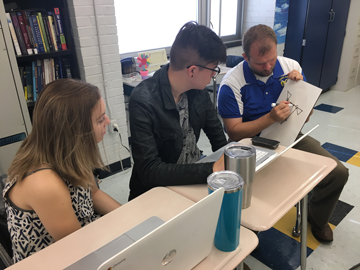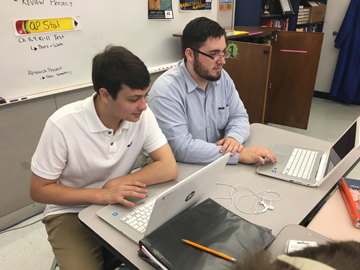Bringing AP CSP to Gaston County, NC
by Joseph Yavelak @jyavelak | September 05, 2017
Joseph Yavelak @jyavelak has been teaching all levels of high school math for more than 12 years and currently teaches at a magnet high school called Highland School of Technology (lottery only) in Gastonia, North Carolina, a region that has seen multiple factory shutdowns over the past few decades and unemployment.
In the summer of 2016, I had the opportunity to receive free computer science professional development (CSPD), also referred to as teacher training, in Raleigh, NC. This training, The Beauty and Joy of Computing, was essential to prepare me to teach an Advanced Placement Computer Science Principles (AP CSP). Designed to give students an exposure to computer science, AP CSP provides them the opportunity to explore and create and do all kinds of things digitally that they wouldn’t get a chance to do in high school otherwise. It also provides students a fun and safe place to start developing an understanding of computing, which will be critical to the jobs of the future.
With about 550 students, Highland School of Technology @HighlandGaston offers a unique experience in our area. Each student enters the school as a member of one of the three academies. Within each academy there are various pathways available for the students, each with its own sequence of required courses. The academies and pathways offered include three distinct academies: Health Sciences Academy, Business Legal & Information Sciences Academy, and Manufacturing/Engineering Technology & Graphics Academy. AP CSP is considered an elective course.
This past school year [2016-17] was the first time I taught AP Computer Science Principles, and the course was part of the College Board’s biggest ever launch in the AP’s 60 year history. I believe offering such a class is important because it gives students the opportunity to work with computers at a foundational level. They don’t start off typing strange code; rather, students start off by exploring and seeing what different kinds of things they can do using programming.

The AP CSP course was offered at Highland during the 2016-2017 school year. I taught 33 students, with a 19:14 ratio between male and female students. My class was made up of 3 juniors and 30 seniors. For many of my students, this was their first, and only, AP course taken during high school.
With this being the first time I had ever taught the class, it was difficult to predict what our class would encounter. The students worked really hard. One student, Christian, shared about what he learned, both about computing and about himself, through this class. “When I first started out I did not really have any idea what I was doing. I now know more about programming than I did before and that was the main goal of the class.” He also learned that he works better in a trial and error environment. He actually enjoyed the struggle, and realized that if he tried something the first time and it failed, he had the freedom to just keep going over and over again, and eventually would get it right. For Christian, this was more satisfying than working off of specific instructions on how to do something and getting the answer right away.
Over the course of the year, my class came up with projects that I previously had not expected to see, much less teach, in a classroom setting. Christian said, “You learn about the social effects and computational effects of programming and what you can do with it and how it can affect us in our daily lives”. The creativity that my students displayed while working on their projects was quite impressive, some of which I could not have imagined while I went through my week-long teacher training course the previous summer.
The programming was at a pretty high level. For example, one student pair, seniors Sonny & Christian took a musical approach to their final project. With pair programming, they used different keyboard keys to simulate playing a piano. By clicking buttons at the bottom, they were able to devise a way to show musical notes, how to play a song, and what the note would sound like. In programming this project, the pair actually learned how to play the piano.

Two other seniors, Will & James, in working together, found out that their skill sets complemented one another. One could stay on task and remain focused while his super creative partner generated many ideas. Together, they learned to work as partners and collaborate to overcome difficulties. They went on to create a text-based adventure based on classmates’ text-writing software in JavaScript from a previous lesson.
I was really impressed with what my inaugural AP CSP class accomplished this past school year. Highland was included as one of 2,500 schools nationwide offering AP CSP and nationally over 45,000 students took the AP CSP end-of-course exam in May 2017. I am pleased to report about 85% of my students went on to take the AP exam, and all earned a passing 3 score or higher. Many students have expressed their intent to study CS further in college.
None of this is possible without support from Infosys Foundation USA whose generosity contributed greatly to the inaugural AP CSP class. Highland would not have been able to offer this class without the help of the Foundation so for that I really want to say thank you.
Here is a video that my inaugural AP CSP students made last year.

